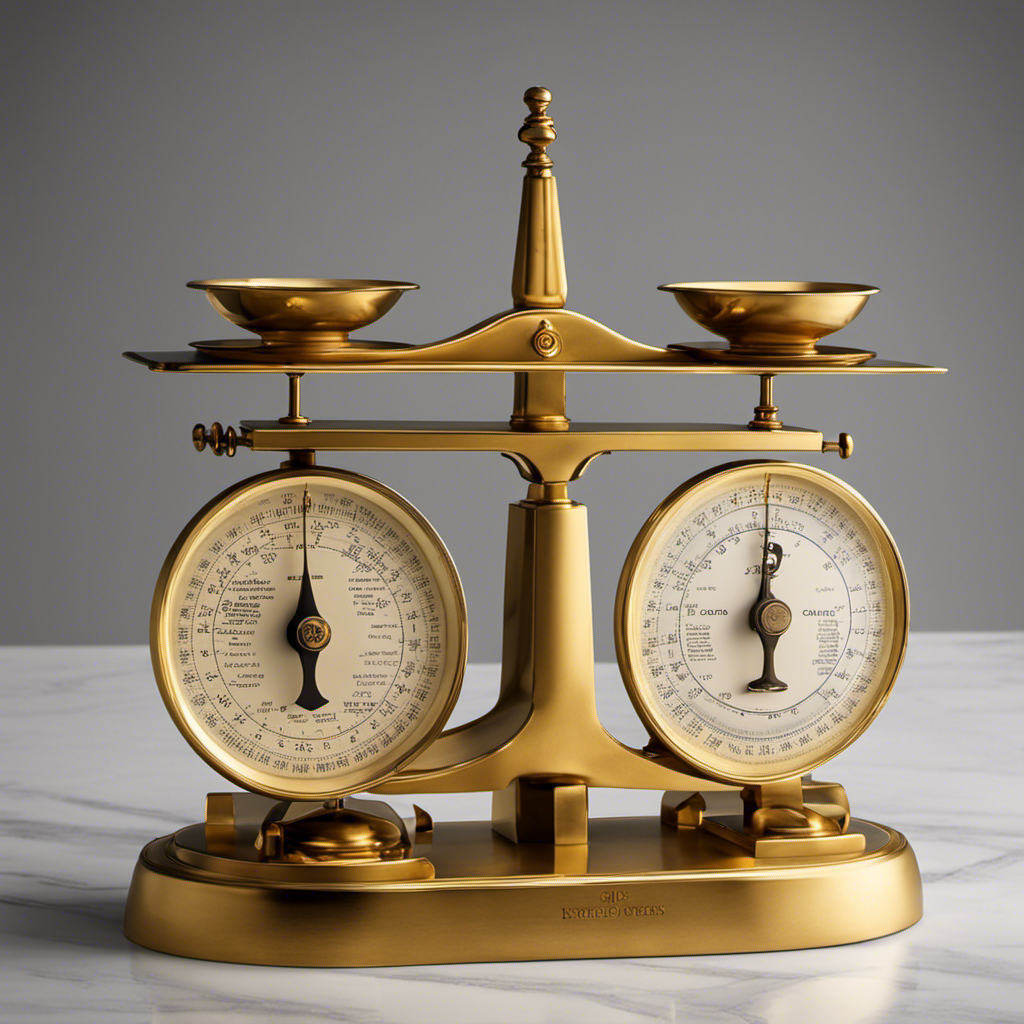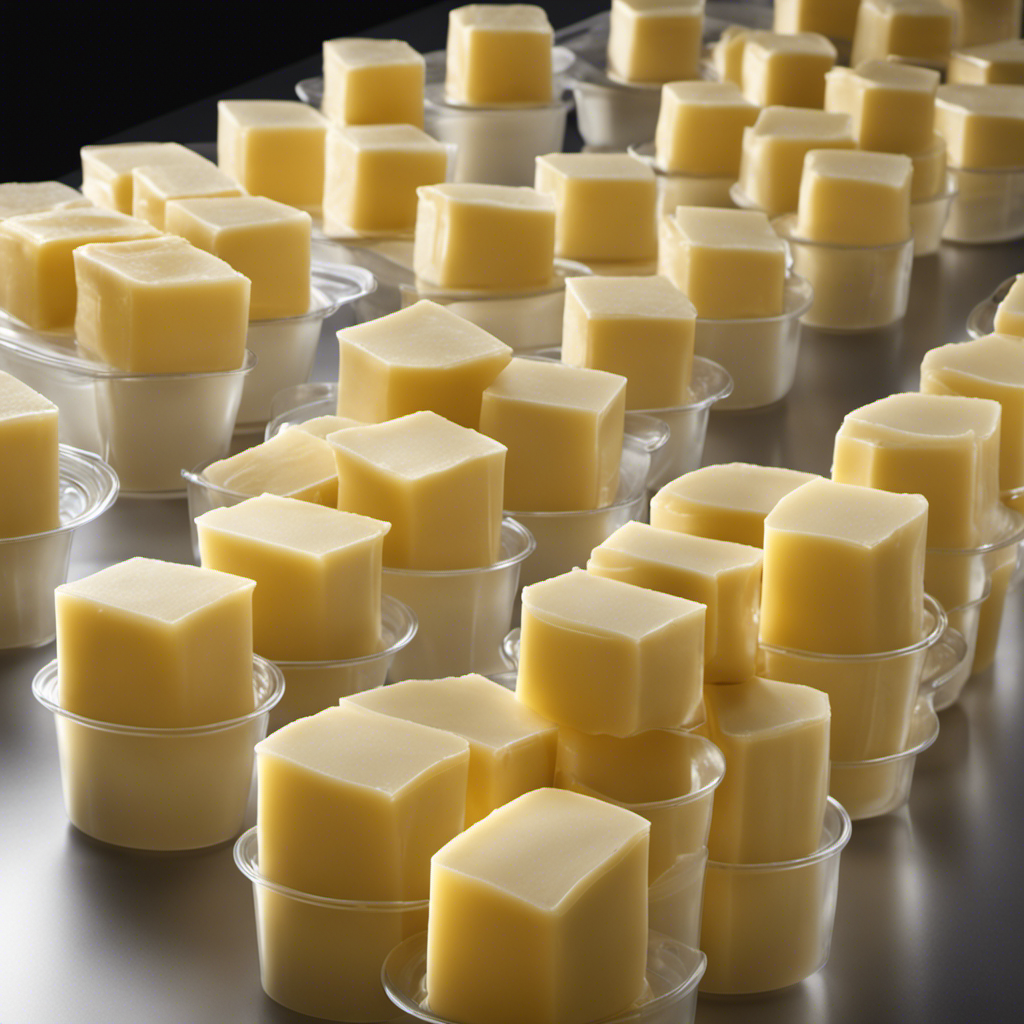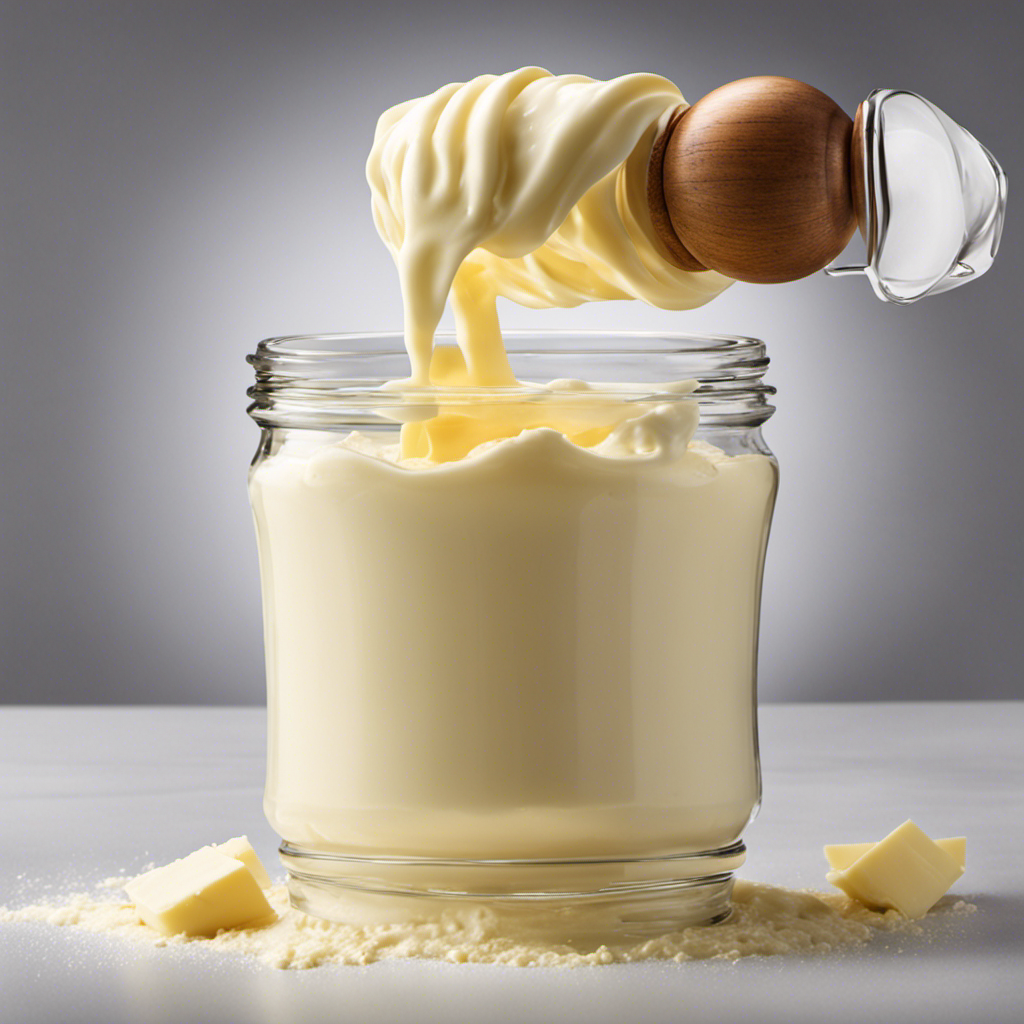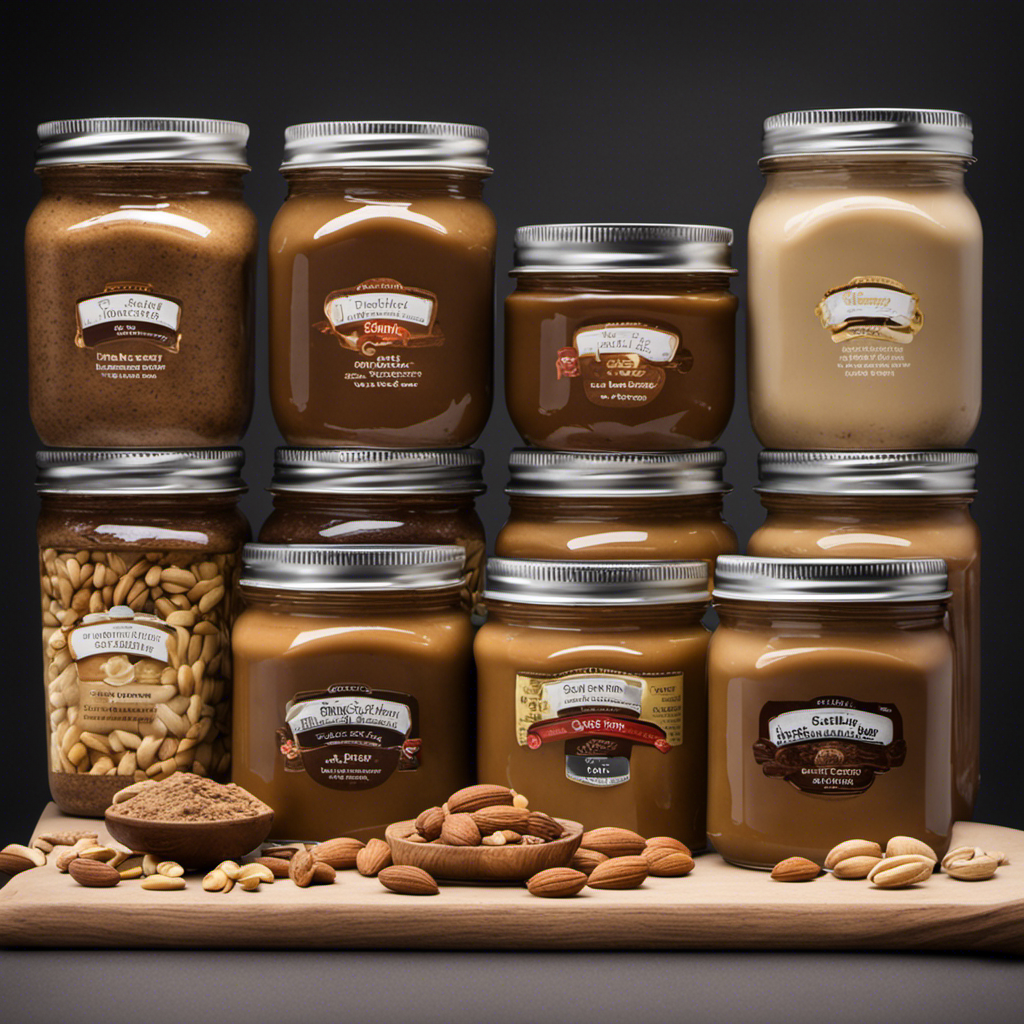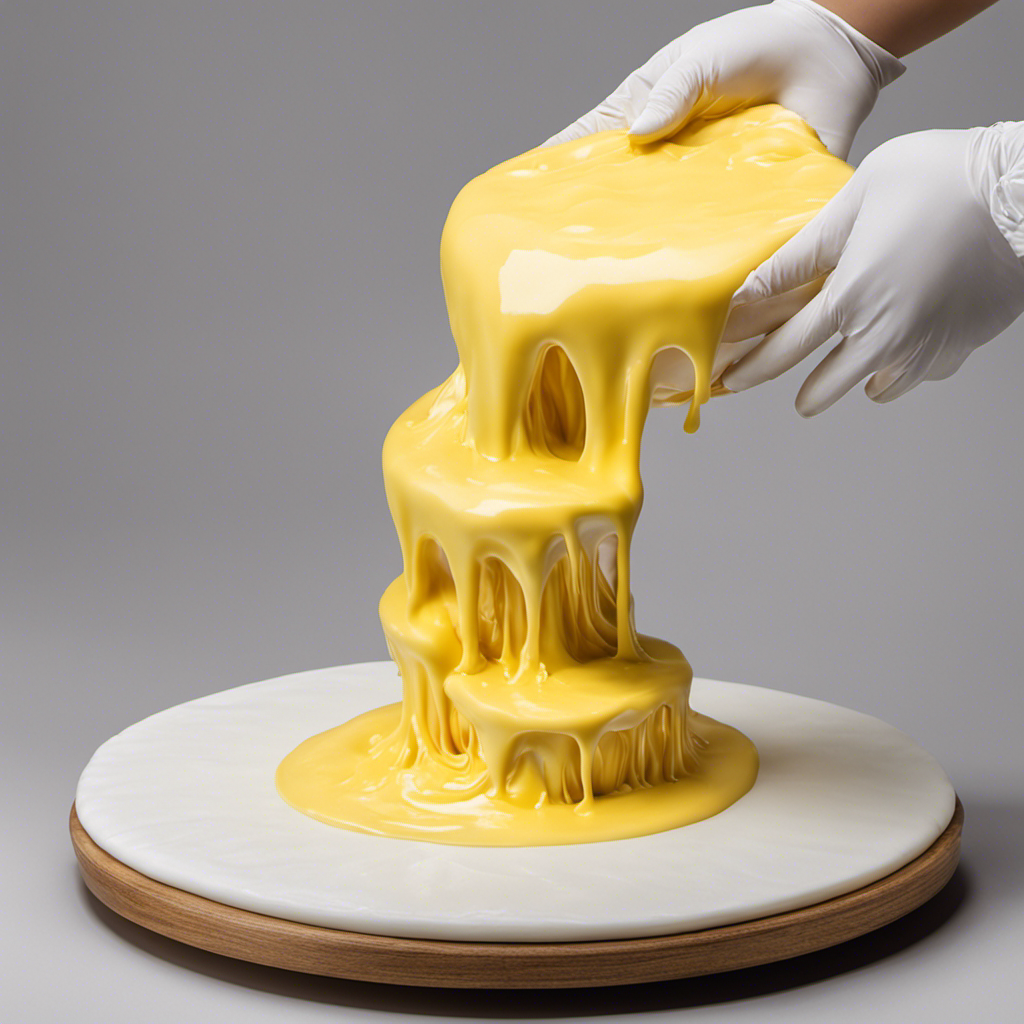I never knew the exact amount of grams in a pound of butter until I began exploring the realm of cooking and baking. It’s a small detail that can have a significant impact on your recipes.
So, to help you out, I’ve put together this informative article that breaks down the conversion rate, explains the weight of butter, and shows you how to measure it in grams.
Get ready to become a butter measurement pro!
Key Takeaways
- Understanding the conversion rate from pounds to grams is crucial for precise calculations.
- Precision in measurements allows for precise plating and presentation.
- Accurate conversions ensure that each component of a dish is in the right proportion.
- Precision in measurements is crucial for achieving the desired results.
Conversion Rate for Grams to Pounds
There are 453.592 grams in a pound of butter. Conversion factors are essential in accurately converting between different units of measurement. When it comes to measuring the weight of butter, knowing the conversion rate from pounds to grams is crucial for precise calculations. By understanding this conversion factor, you can ensure accuracy in your measurements and recipes. It is important to note that using the correct conversion factor is essential to obtain accurate results.
Whether you are baking or cooking, understanding the weight of butter in grams allows you to follow recipes more precisely and achieve consistent results. Now that we have established the conversion rate, let’s delve deeper into understanding the weight of butter and how it varies in different forms and measurements.
Understanding the Weight of Butter
When it comes to butter weight conversions, it’s important to understand the differences between metric and imperial measurements.
Metric measurements, such as grams and kilograms, are used in most countries outside of the United States.
On the other hand, imperial measurements, like ounces and pounds, are commonly used in the United States.
Understanding these two systems of measurement will help you accurately convert butter weights for your recipes.
Butter Weight Conversions
To convert pounds to grams, you can multiply the weight in pounds by 453.592.
Understanding butter density is essential when it comes to converting butter measurements from ounces to grams. Here are three important things to consider:
- Butter density varies depending on its temperature. Softened butter has a higher density compared to chilled or melted butter.
- When converting butter measurements, it’s crucial to know that one pound of butter is equivalent to 16 ounces or approximately 453.592 grams.
- Converting butter from ounces to grams is a simple calculation. Just multiply the weight in ounces by 28.3495 to get the weight in grams.
Metric Vs. Imperial Measurements
By familiarizing myself with both metric and imperial measurements, I can easily navigate between the two systems when following recipes or measuring ingredients.
The metric system, used by most countries around the world, is based on units of 10, making conversions straightforward. It offers precise measurements and is widely used in scientific fields.
On the other hand, the imperial system, used primarily in the United States, can be more familiar for those who grew up with it. It includes units like pounds, ounces, and inches, which can be easier to visualize for certain tasks. However, the imperial system can be more complex to convert and lacks the precision of the metric system.
Overall, understanding both systems provides flexibility and allows for seamless transitions when working with recipes or measurements in various contexts.
Calculating Grams in a Pound
There are 453.592 grams in a pound of butter. Converting butter measurements can be a bit tricky, but once you understand the weight equivalents, it becomes much easier.
Here are three important things to keep in mind:
-
Precision: Butter measurements require precision, especially in baking. Using the correct amount of butter can make a significant difference in the final result of your recipe.
-
Consistency: It is crucial to be consistent with your butter measurements. If a recipe calls for grams, stick to grams throughout the entire process to ensure accurate results.
-
Convenience: Converting butter measurements from pounds to grams allows for easier calculations and precise measurements. It eliminates the need for estimation and provides a more accurate representation of the amount of butter required for a recipe.
How to Measure Butter in Grams
In the previous section, we learned how to calculate the number of grams in a pound of butter. Now, let’s dive into the practical aspect of measuring butter in grams. Converting the weight of butter from pounds to grams is essential for precision in baking and cooking. To make things easier, I have prepared a helpful table:
| Butter Measurement | Grams |
|---|---|
| 1/4 pound | 113g |
| 1/2 pound | 227g |
| 1 pound | 454g |
Grams Vs. Ounces: Butter Weight Comparison
When it comes to measuring butter, it’s important to understand the conversion factors between grams and ounces. This knowledge allows for precision in measurements, ensuring accurate results in recipes.
In this discussion, we will explore the conversion factors for butter, compare grams to ounces, and highlight the importance of precision when measuring ingredients.
Conversion Factors for Butter
To convert pounds of butter to grams, simply multiply the number of pounds by 453.6. This simple calculation allows you to easily determine the weight of butter in grams.
Here are some butter weight equivalents and a butter conversion chart that might evoke some emotions:
- 1 pound of butter equals 453.6 grams, which is a lot of creamy goodness!
- Did you know that 2 pounds of butter is equivalent to a whopping 907.2 grams? That’s enough to satisfy a crowd!
- And if you ever need to measure a smaller amount, 1/2 a pound of butter converts to 226.8 grams, perfect for baking a delicious batch of cookies.
Having a butter conversion chart handy can save you time and effort in the kitchen. So the next time you’re cooking or baking with butter, remember these conversions and enjoy the ease and accuracy they provide.
Grams or Ounces
Remember that using a kitchen scale can help you accurately measure the weight of ingredients in recipes, whether it be in grams or ounces.
When it comes to butter, the conversion rate can be a bit tricky. Most butter packaging in the United States typically displays the weight in ounces, while in other countries, grams are more commonly used.
To convert between the two, you need to know that 1 pound of butter is equal to 16 ounces or approximately 454 grams. So, if a recipe calls for 1 pound of butter and you prefer to use grams, you would need around 454 grams.
Similarly, if a recipe calls for 200 grams of butter and you only have a kitchen scale that measures in ounces, you would need around 7 ounces of butter.
Precision in Measurements
Using a kitchen scale is essential for accurately measuring ingredients in recipes. Precision in measurements is crucial when it comes to baking and cooking. Here are three reasons why accurate conversions are important:
-
Avoiding recipe failures: Inaccurate measurements can throw off the balance of ingredients, resulting in a failed dish. To ensure the desired texture and taste, precise measurements are necessary.
-
Consistency in taste: Accurate conversions allow for consistent results every time you make a recipe. By using the right amounts of ingredients, you can ensure that your dishes taste the same and meet your expectations.
-
Professional presentation: Precision in measurements allows for precise plating and presentation. Accurate conversions ensure that each component of a dish is in the right proportion, creating an aesthetically pleasing and visually appealing final product.
With the importance of precision in measurements established, let’s now explore the process of converting butter measurements from pounds to grams.
Converting Butter Measurements: Pounds to Grams
There’s 453.6 grams in a pound of butter. When it comes to converting butter measurements, it’s important to be precise. One common conversion you might come across is ounces to grams. To make things easier, I’ve created a table below that shows the conversion for commonly used butter packaging sizes:
| Butter Packaging Size | Ounces | Grams |
|---|---|---|
| Stick | 4 | 113.4 |
| Half stick | 2 | 56.7 |
| Quarter stick | 1 | 28.4 |
| Tub | 16 | 453.6 |
| Tub (small) | 8 | 226.8 |
This table provides a quick reference for converting butter measurements. Whether you’re following a recipe or planning your own creations, knowing the exact measurements is crucial for achieving the desired results.
Butter Measurement Guide: Grams per Pound
When converting measurements, it’s helpful to have a guide that shows the equivalent amounts in different units. Butter is a common ingredient in many recipes, and knowing the measurements in grams per pound can be useful.
Here are some butter measurement techniques and common packaging sizes to help you in your cooking adventures:
- 1 pound of butter is equal to approximately 453.6 grams.
- Common butter packaging sizes include 1 pound (454 grams), 1/2 pound (227 grams), and 1/4 pound (113 grams).
- Some butter brands may also offer smaller packaging sizes, such as 1/2 stick (57 grams) or 1/4 stick (28 grams).
Having a clear understanding of these measurements will ensure that you use the right amount of butter in your recipes, resulting in delicious and perfectly balanced dishes. So, next time you reach for that stick of butter, you’ll know exactly how much you’re using. Happy cooking!
Frequently Asked Questions
Is There a Difference in Weight Between Unsalted and Salted Butter?
There is a difference in taste and nutritional value between unsalted and salted butter. The amount of salt in salted butter can impact recipe outcomes, so it’s important to consider this when cooking or baking.
Can I Use a Regular Kitchen Scale to Measure Butter in Grams?
Certainly! Using a kitchen scale to measure butter in grams is a precise and efficient way. It allows for accurate portion control and helps in consuming smaller gram measurements, which can be beneficial for managing calorie intake.
How Many Sticks of Butter Are in a Pound?
There are 4 sticks of butter in a pound. Each stick weighs 113 grams. It’s important to note that the taste and culinary uses of butter may vary depending on the brand and type.
Are There Any Health Benefits to Consuming Butter in Smaller Gram Measurements?
Consuming smaller amounts of butter can have health benefits. Research shows that moderate butter intake may not significantly impact cholesterol levels. However, it’s important to maintain a balanced diet and consult a healthcare professional for personalized advice.
Is It Possible to Convert Grams to Ounces When Measuring Butter?
Yes, it is possible to convert grams to ounces when measuring butter. It’s important to accurately measure butter for baking recipes and especially in pastry making, where precise measurements can affect the outcome.
Conclusion
Wow, who knew that measuring butter could be so complicated? But fear not, my butter-loving friends, because now you have all the knowledge you need to convert those pesky pounds into handy grams.
With my handy guide, you can measure your butter with precision and accuracy. No more guessing or approximating – now you can be the butter-measuring master!
So, go forth and conquer those recipes with confidence, armed with the knowledge of exactly how many grams are in a pound of butter.
Happy cooking!
